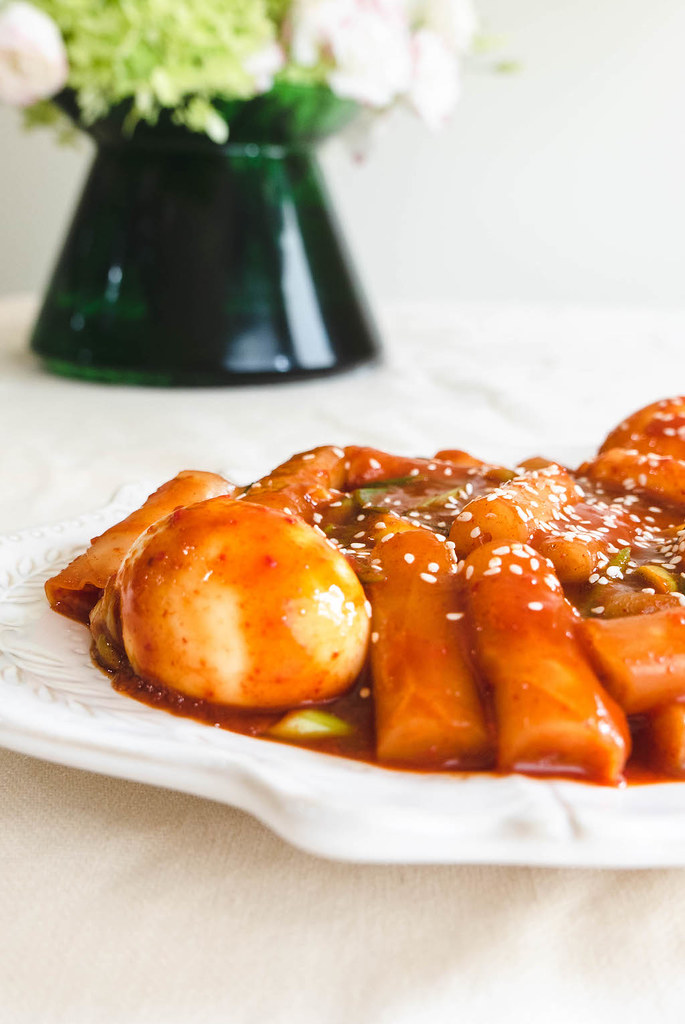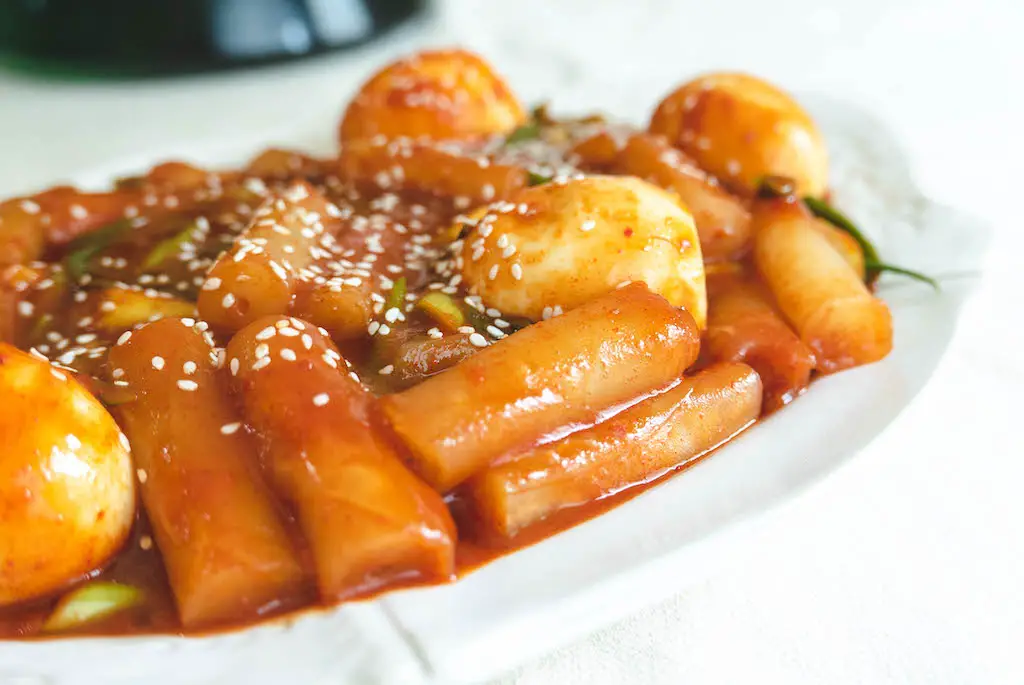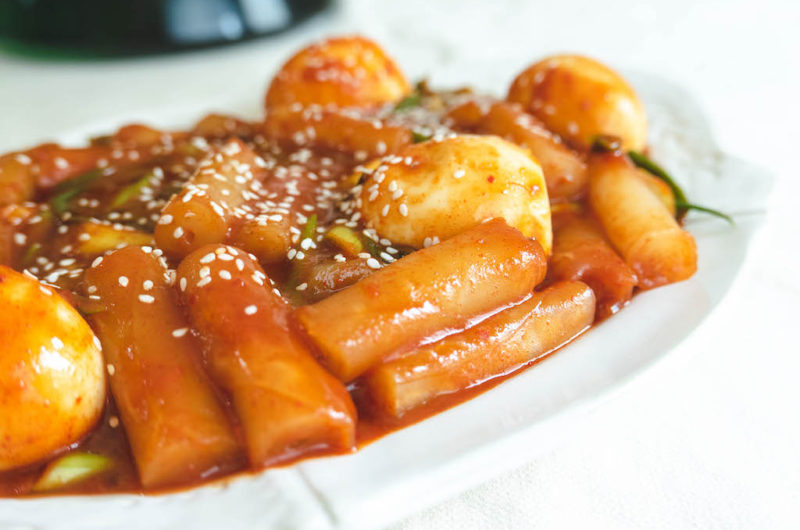This post may contain affiliate links. Please read my disclosure for details at the bottom of this page. As an Amazon Associate, I earn from qualifying purchases on this Korean rice paper tteokbokki recipe post.
Of late, have you seen the new rice paper tteokbokki hack? Recently, during the spring and summer of 2021, this recipe idea started trending in South Korea. Instead of using the typical tteok (Korean rice cakes) in the tteokbokki, people are replacing it with rolled rice paper. I decided to write about this recipe after seeing it on my sister-in-law’s amazing vlog Youtube Channel. You can check it out via this link–She cooks the rice paper tteokbokki at the 13:18 mark!
I am excited about this recent trend for a few reasons. First, Korean tteok can be very difficult to find if you do not live near an Asian grocery store. Because they need to be refrigerated, I have a hard time ordering them online for fear they will not be shipped properly. Second, many tteok brands contain wheat. For those who are gluten-free (like me), this can be disheartening. Thankfully, someone came up with this ingenious idea. Why didn’t I think of doing this sooner?!
But, before we get into the recipe, I wanted to walk you through an explanation of Korean tteokbokki, as well as some cooking tips & tricks. Then, I will answer some potential questions you may have about this recipe! So, let’s get started!
What Is Tteokbokki?
First, what is tteokbokki? Tteokbokki (떡볶이) is a stir-fried rice cake dish. The word ‘tteok’ (떡) means ‘rice cake’ in Korean, while the word ‘bokki’ (볶이)refers to something ‘stir-fried.’ The word ‘bokki’ stems from the word ‘bokkeum’ (볶음) which is the generic word for ‘stir-fried.’ The word ‘bokkeum’ is a verbal noun derived from the verb ‘bokkda (볶다), which means ‘to cook dried ingredients over heat.’
To make tteokbokki, you start by preparing the bright red sauce. You can make the sauce mild or spicy, but the sauce ingredients typically include:
- Gochujang: Korean Red Pepper Paste
- Gochugaru: Korean Red Pepper Powder
- Ganjang: Korean Soy Sauce
- A Sweetener: Such as Corn Syrup, Malt Syrup, Sugar, or Honey; And
- Water

Once you combine and heat the sauce until it boils, you add in the tteok. The tteok will soften as they cook and naturally thicken the sauce. Finally, you add further ingredients such as eomuk (Korean fish cakes), green onions, and/or eggs. Serve hot!
The resulting dish is both a bit sweet and spicy. The rice cakes have a texture similar to Italian gnocchi.
Pop culture made tteokbokki an in-demand spicy treat outside South Korea–For those interested in Korean pop culture, you will often see people eating it in Korean dramas as well as in reality tv shows and celebrity live streams.
How Do You Make Rice Paper Tteokbokki?
Now that we know about tteokbokki, what is rice paper tteokbokki? To make this recipe, you replace the traditional Korean tteok (rice cakes), with rice paper! While the mouthfeel is similar, this rice paper version has a chewier texture. In the Korean language, they describe this deliciously chewy texture as ‘jjeol-kit, jjeol-kit’ (쫄깃쫄깃).

Tips & Tricks for Rolling the Rice Paper:
- To use the rice paper, you must first start by wetting it in warm water for a few seconds. This softens the rice paper so it becomes pliable. Then, lay the wet rice paper on a flat surface and roll it tightly into a cylinder.
- After testing, I found that you can use either square or circular rice paper. If you use the square, simply roll it tightly away from you. If you use circular, start by folding in the sides. This allows you to make straight borders to work with! Then, once you form the straight edges, you can roll it away from you. While the square sheets are easier to use, I find that most grocery stores sell circular versions. In the photos, I used circular sheets of rice paper!
- I recommend using more than one sheet of rice paper per roll to make it as thick as regular tteok. In my opinion, two sheets work best to get the proper thickness. To do this, layer about an inch of one wet sheet over the other on a flat surface. Then, roll them together.
- Once you roll them, slice the cylinders into tteok-sized pieces. I found you can slice them into thirds.

- If you want cheesy tteokbokki, you can add American or mozzarella cheese slices over the rice paper before rolling. Then, once you add your homemade tteok to the sauce, the cheese will melt in the center.
- Typically, as the tteok softens, it releases starches that thicken the tteokbokki sauce. Unfortunately, the rice paper does not do the same. For this recipe, you will thicken the sauce with cornstarch!
Korean Rice Paper Tteokbokki Frequently Asked Questions:
Below, we listed some questions you may have about this Korean rice paper tteokbokki recipe. If we do not answer your question below, feel free to leave a comment or email us at [email protected]!
Is This Recipe Free of Major Allergens? (Gluten, Soy, Dairy, Etc.)
While tteokbokki typically contains major allergens, you can easily replace the ingredients to fit your needs!
- Gluten-Free: To make this dish gluten-free, replace the soy sauce and gochujang with gluten-free alternatives. You can check out our blog posts recommending gluten-free soy sauce and gluten-free gochujang brands! Unfortunately, you will need to completely omit the eomuk (Korean fish cakes) because most brands available outside South Korea contain wheat. Finally, always check the rice paper to make sure you get a gluten-free brand. Once in awhile, they contain wheat!
- Soy-Free: To make this dish soy-free, replace the soy sauce with coconut aminos!
- Egg-Free: Tteokbokki is naturally egg-free. That being said, restaurants and home cooks often add boiled eggs to the dish. If you do eat out, request they omit the egg.
- Shellfish and Seafood Allergies: When cooking with gochujang, always check to see if it contains any type of seafood. Sometimes, it contains ingredients such as fermented fish or shellfish. Also, if you do have a seafood allergy, omit any type of rice cake from the dish!
- Dairy: Tteokbokki is naturally free of any dairy. That being said, people often top this dish with cheese. If you have a milk allergy or lactose intolerance make sure to request that no cheese be added.
- Peanuts and Tree Nuts: This rice paper tteokbokki recipe is naturally free of any type of nut!
If you have any other allergies and are not certain of ingredients, feel free to email me! I can help you out!

What Can You Serve With Tteokbokki?
I like serving tteokbokki with pickled radish and sundae (Korean blood sausage)! You can find both in your local Asian grocery store. Unfortunately, you may not be able to find these ingredients or items in non-Asian grocery stores.
If you do not have a local Asian grocery store, I recommend buying ramen noodles. You can add these to the dish to make rabokki! Rabokki is a combination of tteokbokki and ramen!
Can You Make This Recipe In Advance?
While many Korean recipes like maneul jangajji and yeongeun jorim can be made far in advance, I believe tteokbokki should be made right before serving. As the tteok sits in the hot sauce, it gets softer and softer as it continues to cook. You do not want soggy food! The same is true of this rice paper version. If you let it sit for too long, the rice paper will fall apart instead of holding together the chewy texture!
How Should I Store Leftovers?
To store this rice paper tteokbokki, place it in an airtight container. Then, let it cool before adding it to the refrigerator.
Leftover tteokbokki does not microwave well. To reheat, place the tteokbokki in an appropriate-sized pot. Then, add a few tablespoons of water and reheat on medium-low heat. While reheating, make sure to stir often so you do not burn the bottom of the pot. Serve hot!

We Hope You Enjoyed Learning About This Korean Rice Paper Tteokbokki Recipe!
In the end, we hope you enjoyed learning about this Korean rice paper tteokbokki recipe. If so, let us know in the comment section below. Also, we would love to hear about your favorite uses for rice paper!
If you would like to read more about cooking, you can find further recipes on our blog. We listed some of our favorite Carving A Journey Korean recipes below! For reference, many recipes are influenced by our blended Korean and Southern heritage.

Carving A Journey Korean Recipes:
- Korean Braised Lotus Roots
- Tteokkochi (Korean Rice Cake Skewers)
- Jumeokbap (Handmade Korean Rice Balls)
- Bibimmyeon (Korean Spicy Cold Noodles); And
- Korean Banana Flavored Milk
If you have any questions or comments, you can also email us at [email protected].
And, finally, we would love to hear from you through our social media as well! You can follow us at @carvingajourney on Instagram, Twitter, Facebook, and Pinterest. Or, if you would like more articles like these, you can subscribe to our blog by joining our mailing list. We hope you enjoyed reading about this Korean rice paper tteokbokki recipe! Thank you so much for stopping by!
Carving A Journey is a participant in the Amazon Services LLC Associates Program, an affiliate advertising program designed to provide a means for sites to earn advertising fees by advertising and linking to Amazon.com. Although we may earn commissions for our endorsement, recommendation, testimonial, and/or link to any products or services from this website, these opinions are my own and I fully support these products.


